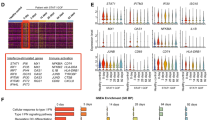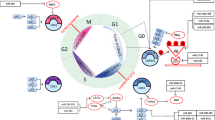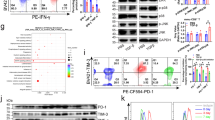Abstract
We investigated the role of miR-522-3p in thymoma-associated myasthenia gravis (TAMG), and the mechanism of action in T cells. The miR-522-3p expression in normal serum, non-thymoma MG patient serum and TAMG patient serum and tissues was detected by quantitative real-time PCR (qRT-PCR), respectively. We assessed miR-522-3p expression in Jurkat cells and human CD4+ T cells after activation by anti-CD3 and anti-CD28 using qRT-PCR. The viability, proliferation, cycle distribution and the levels of CD25, CD69, interleukin-2 (IL-2) and IL-10 in transfected Jurkat cells were detected by Cell counting kit-8, 5-ethynyl-2′-deoxyuridine (EdU), flow cytometry, qRT-PCR, respectively. Targeting relationships of miR-522-3p and SLC31A1 were predicted and validated by bioinformatics analysis and dual-luciferase reporter. The viability, proliferation, cycle distribution and the levels of SLC31A1, CD25, CD69, IL-2 and IL-10 in transfected Jurkat cells were detected by above methods and western blot. The miR-522-3p expression was declined in TAMG and activated T cells. MiR-522-3p inhibitor promoted cell viability, EdU positive cells, cycle progression, and the level of CD25, CD69, IL-2 and IL-10 in Jurkat cells, while the effect of miR-522-3p mimic was the opposite. SLC31A1 was targeted by miR-522-3p, and miR-522-3p inhibited SLC31A1 expression. Overexpressed SLC31A1 reversed the inhibitory effects of miR-522-3p mimic on cell viability, EdU positive cell, cycle progression, and the levels of IL-2 and IL-10 in transfected Jurkat cells. MiR-522-3p expression was down-regulated in TAMG, and miR-522-3p inhibited proliferation and activation by regulating SLC31A1 expression in T cells.





Similar content being viewed by others
References
Ao W, Tian C, He X, Hu Y, Wang W, Liu Y (2020) Upregulation of miR150–5p in generalized myasthenia gravis patients is associated with decreased serum levels of IL-17 and increased serum levels of IL-10. Biomed Pap Med Fac Univ Palacky Olomouc Czech Repub 164:57–62. https://doi.org/10.5507/bp.2019.009
BeloorSuresh A, Asuncion RMD (2020) Myasthenia gravis. StatPearls, Treasure Island
Bouchikh M, El Malki HO, Ouchen F, Achir A, Benosman A (2013) Thymoma-associated myasthenia gravis: clinical features and surgical results. Rev Neurol (Paris) 169:879–883. https://doi.org/10.1016/j.neurol.2013.01.625
Cao Y et al (2017) Construction of an miRNA-regulated drug-pathway network reveals drug repurposing candidates for myasthenia gravis. Int J Mol Med 39:268–278. https://doi.org/10.3892/ijmm.2017.2853
de Meel RHP, Tannemaat MR, Verschuuren J (2019) Heterogeneity and shifts in distribution of muscle weakness in myasthenia gravis. Neuromuscul Disord 29:664–670. https://doi.org/10.1016/j.nmd.2019.07.006
De Rosa A et al (2020) Thymoma-associated myasthenia gravis: clinical features and predictive value of antiacetylcholine receptor antibodies in the risk of recurrence of thymoma. Thorac Cancer. https://doi.org/10.1111/1759-7714.13724
Flynn MJ, Hartley JA (2017) The emerging role of anti-CD25 directed therapies as both immune modulators and targeted agents in cancer. Br J Haematol 179:20–35. https://doi.org/10.1111/bjh.14770
Goljanek-Whysall K, Pais H, Rathjen T, Sweetman D, Dalmay T, Munsterberg A (2012) Regulation of multiple target genes by miR-1 and miR-206 is pivotal for C2C12 myoblast differentiation. J Cell Sci 125:3590–3600. https://doi.org/10.1242/jcs.101758
Hasegawa A, Nakayama T (2010) Role of CD69 in the pathogenesis of inflammation. Nihon Rinsho Meneki Gakkai Kaishi 33:189–195. https://doi.org/10.2177/jsci.33.189
Hayashi R, Tahara M, Oeda T, Konishi T, Sawada H (2015) A case of refractory generalized myasthenia gravis with anti-acetylcholine receptor antibodies treated with rituximab. Rinsho Shinkeigaku 55:227–232. https://doi.org/10.5692/clinicalneurol.55.227
Huang G, Zhou X, Yao D (2020) Report of a case of necrotizing autoimmune myopathy with thymoma-associated myasthenia gravis. Int J Neurosci 130:1178–1181. https://doi.org/10.1080/00207454.2020.1730366
Lee MC et al (2020) Molecular profiling of thymoma with myasthenia gravis: risk factors of developing myasthenia gravis in thymoma patients. Lung Cancer 139:157–164. https://doi.org/10.1016/j.lungcan.2019.11.007
Li J, Qiu D, Chen Z, Du W, Liu J, Mo X (2016) Altered expression of miR-125a-5p in thymoma-associated myasthenia gravis and its down-regulation of foxp3 expression in Jurkat cells. Immunol Lett 172:47–55. https://doi.org/10.1016/j.imlet.2016.02.005
Li W et al (2014) MiR-568 inhibits the activation and function of CD4(+) T cells and Treg cells by targeting NFAT5. Int Immunol 26:269–281. https://doi.org/10.1093/intimm/dxt065
Molin CJ, Sabre L, Weis CA, Punga T, Punga AR (2018) Thymectomy lowers the myasthenia gravis biomarker miR-150–5p. Neurol Neuroimmunol Neuroinflamm 5:e450. https://doi.org/10.1212/NXI.0000000000000450
Monga I, Kumar M (2019) Computational resources for prediction and analysis of functional miRNA and their targetome. Methods Mol Biol 1912:215–250. https://doi.org/10.1007/978-1-4939-8982-9_9
Peragallo JH (2017) Pediatric myasthenia gravis. Semin Pediatr Neurol 24:116–121. https://doi.org/10.1016/j.spen.2017.04.003
Punga T, Le Panse R, Andersson M, Truffault F, Berrih-Aknin S, Punga AR (2014) Circulating miRNAs in myasthenia gravis: miR-150–5p as a new potential biomarker. Ann Clin Transl Neurol 1:49–58. https://doi.org/10.1002/acn3.24
Qi G, Liu P, Dong H, Gu S, Yang H, Xue Y (2017) Metastatic thymoma-associated myasthenia gravis: favorable response to steroid pulse therapy plus immunosuppressive agent. Med Sci Monit 23:1217–1223. https://doi.org/10.12659/msm.902442
Robinson SP, Akhondi H (2020) Thymoma. StatPearls, Treasure Island (FL)
Schweigel-Rontgen M (2014) The families of zinc (SLC30 and SLC39) and copper (SLC31) transporters. Curr Top Membr 73:321–355. https://doi.org/10.1016/B978-0-12-800223-0.00009-8
Shah P et al (2015) DNA/RNA chimera templates improve the emission intensity and target the accessibility of silver nanocluster-based sensors for human microRNA detection. Analyst 140:3422–3430. https://doi.org/10.1039/c5an00093a
Shuai F, Wang B, Dong S (2018) miR-522–3p promotes tumorigenesis in human colorectal cancer via targeting bloom syndrome. Protein Oncol Res 26:1113–1121. https://doi.org/10.3727/096504018X15166199939341
Toda H et al (2020) RNA-sequence-based microRNA expression signature in breast cancer: tumor-suppressive miR-101–5p regulates molecular pathogenesis. Mol Oncol 14:426–446. https://doi.org/10.1002/1878-0261.12602
Uzawa A et al (2020) Frequency and features of myasthenia gravis developing after thymectomy. Eur J Neurol 27:175–180. https://doi.org/10.1111/ene.14052
Velez-Santamaria V, Nedkova V, Diez L, Homedes C, Alberti MA, Casasnovas C (2020) Eculizumab as a promising treatment in thymoma-associated myasthenia gravis. Ther Adv Neurol Disord 13:1756286420932035. https://doi.org/10.1177/1756286420932035
Wang F et al (2019) H19X-encoded miR-424(322)/-503 cluster: emerging roles in cell differentiation, proliferation, plasticity and metabolism. Cell Mol Life Sci 76:903–920. https://doi.org/10.1007/s00018-018-2971-0
Xie Y, Du J, Liu Z, Zhang D, Yao X, Yang Y (2019) MiR-6875–3p promotes the proliferation, invasion and metastasis of hepatocellular carcinoma via BTG2/FAK/Akt pathway. J Exp Clin Cancer Res 38:7. https://doi.org/10.1186/s13046-018-1020-z
Xin Y, Cai H, Lu T, Zhang Y, Yang Y, Cui Y (2016) miR-20b inhibits T cell proliferation and activation via NFAT signaling pathway in thymoma-associated myasthenia gravis. Biomed Res Int 2016:9595718. https://doi.org/10.1155/2016/9595718
Yamada Y, Weis CA, Thelen J, Sticht C, Schalke B, Strobel P, Marx A (2020) Thymoma associated myasthenia gravis (TAMG): differential expression of functional pathways in relation to MG status in different thymoma histotypes. Front Immunol 11:664. https://doi.org/10.3389/fimmu.2020.00664
Yasukawa K, Kinoshita D, Yaku K, Nakagawa T, Koshiba T (2020) The microRNAs miR-302b and miR-372 regulate mitochondrial metabolism via the SLC25A12 transporter, which controls MAVS-mediated antiviral innate immunity. J Biol Chem 295:444–457. https://doi.org/10.1074/jbc.RA119.010511
Yu L, Ke J, Du X, Yu Z, Gao D (2019) Genetic characterization of thymoma. Sci Rep 9:2369. https://doi.org/10.1038/s41598-019-38878-z
Zhang B, Pan X, Cobb GP, Anderson TA (2007) microRNAs as oncogenes and tumor suppressors. Dev Biol 302:1–12. https://doi.org/10.1016/j.ydbio.2006.08.028
Zhang T et al (2016) Downregulation of miR-522 suppresses proliferation and metastasis of non-small cell lung cancer cells by directly targeting DENN/MADD domain containing 2D. Sci Rep 6:19346. https://doi.org/10.1038/srep19346
Zhang W, Wei L, Sheng W, Kang B, Wang D, Zeng H (2020) miR-1225–5p functions as a tumor suppressor in osteosarcoma by targeting Sox9 DNA. Cell Biol 39:78–91. https://doi.org/10.1089/dna.2019.5105
Funding
This work was supported by the Weifang Science and Technology Development Plan Project [Grant No. 2017YX037].
Author information
Authors and Affiliations
Contributions
Substantial contributions to conception and design: HL. Data acquisition, data analysis and interpretation: HW, PS, JW, SL, TX. Drafting the article or critically revising it for important intellectual content: HL. Final approval of the version to be published: HL, HW, PS, JW, SL, TX. Agreement to be accountable for all aspects of the work in ensuring that questions related to the accuracy or integrity of the work are appropriately investigated and resolved: HL, HW, PS, JW, SL, TX.
Corresponding author
Ethics declarations
Conflict of interest
The authors declare no conflicts of interest.
Additional information
Publisher's Note
Springer Nature remains neutral with regard to jurisdictional claims in published maps and institutional affiliations.
Rights and permissions
About this article
Cite this article
Lu, H., Wang, H., Sun, P. et al. MiR-522-3p inhibits proliferation and activation by regulating the expression of SLC31A1 in T cells. Cytotechnology 73, 483–496 (2021). https://doi.org/10.1007/s10616-021-00472-5
Received:
Accepted:
Published:
Issue Date:
DOI: https://doi.org/10.1007/s10616-021-00472-5




